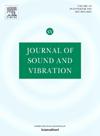A displacement formulation for coupled elastoacoustic problems that preserves flow irrotationality
IF 4.3
2区 工程技术
Q1 ACOUSTICS
引用次数: 0
Abstract
Two-way fluid–structure interaction (FSI) problems, in the sense that a flow induces the motion of a solid, which in turn modifies the flow boundary conditions, have been approached with very different strategies, the most common of which is probably the finite element method (FEM). In the case of elastoacoustics, the flow consists of an acoustic field interacting with a vibrating structure. When the problem is discretized with the FEM, an algebraic block matrix system is obtained and the coupling between the acoustic field and the structure takes place through a coupling matrix with off-diagonal terms. Usually the structure is characterized by its displacement field, while for the acoustics several options are available, ranging from pressure to acoustic displacement or velocity/displacement acoustic potentials. Depending on the formulation, symmetric or asymmetric systems are obtained and different types of numerical stability problems have to be faced. In this work, a monolithic strategy based on the Rayleigh–Ritz method is proposed. The displacement is used as the primary variable for both the structure and the acoustic field and is expanded in terms of Gaussians as basis functions. This provides an algebraic block matrix system for the global uncoupled problem. However, instead of resorting to a coupling matrix, the essential continuity conditions at the acoustic-structure interface are imposed by the nullspace method (NSM). That is, the solution of the uncoupled system is expanded in terms of a basis of the nullspace generated by the essential conditions of the problem, including the displacement continuity constraints at the interface, thus giving the solution of the coupled problem. As for natural conditions, they are imposed in a weak sense. For ease of explanation, a one-dimensional (1D) case is first introduced, followed by the coupling of a 2D acoustic cavity with a beam and a 3D one with a plate. The proposed method is validated with FEM simulations on fine meshes and the advantage of using Gaussian basis functions over trigonometric ones is also demonstrated.
保留流动不旋转性的耦合弹声问题位移公式
对于双向流固耦合(FSI)问题,即流动引起固体运动,而固体运动又改变流动边界条件的问题,人们采用了多种不同的方法,其中最常用的可能是有限元法(FEM)。在弹性声学中,流动由声场与振动结构相互作用组成。当使用有限元法对问题进行离散化处理时,会得到一个代数分块矩阵系统,声场与结构之间的耦合是通过一个带对角项的耦合矩阵实现的。结构通常以其位移场为特征,而声学则有多种选择,包括压力、声位移或速度/位移声势。根据公式的不同,会得到对称或不对称的系统,并面临不同类型的数值稳定性问题。在这项工作中,提出了一种基于 Rayleigh-Ritz 方法的整体策略。位移被用作结构和声场的主变量,并以高斯作为基函数展开。这就为全局非耦合问题提供了一个代数分块矩阵系统。不过,在声学-结构界面上的基本连续性条件不是通过耦合矩阵,而是通过无效空间法(NSM)来实现的。也就是说,非耦合系统的解是根据问题的基本条件(包括界面上的位移连续性约束)生成的无效空间的基础展开的,从而得到耦合问题的解。至于自然条件,它们是在弱意义上施加的。为便于解释,首先介绍一维(1D)情况,然后是二维声腔与梁的耦合和三维声腔与板的耦合。所提出的方法通过精细网格上的有限元模拟进行了验证,并证明了使用高斯基函数比使用三角函数的优势。
本文章由计算机程序翻译,如有差异,请以英文原文为准。
求助全文
约1分钟内获得全文
求助全文
来源期刊

Journal of Sound and Vibration
工程技术-工程:机械
CiteScore
9.10
自引率
10.60%
发文量
551
审稿时长
69 days
期刊介绍:
The Journal of Sound and Vibration (JSV) is an independent journal devoted to the prompt publication of original papers, both theoretical and experimental, that provide new information on any aspect of sound or vibration. There is an emphasis on fundamental work that has potential for practical application.
JSV was founded and operates on the premise that the subject of sound and vibration requires a journal that publishes papers of a high technical standard across the various subdisciplines, thus facilitating awareness of techniques and discoveries in one area that may be applicable in others.
 求助内容:
求助内容: 应助结果提醒方式:
应助结果提醒方式:


